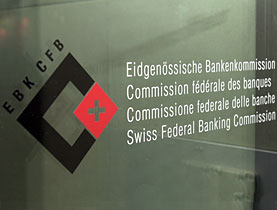Banks resist tighter regulatory proposals

Switzerland's main banks, UBS and Credit Suisse, have reacted scathingly to suggestions they should put aside more money to guard against future financial crises.
The Swiss Federal Banking Commission (SFBC) and the Swiss National Bank (SNB) have both recommended that the two banks increase safeguards following the damaging subprime mortgage crash in the United States.
UBS has been forced to write down SFr39 billion in recent months while Credit Suisse has also lost around SFr8 billion.
Both subscribe to the Basel II banking regulations that stipulate how much capital must be set aside to cover potential risks. They also voluntarily apply the so-called “Swiss finish” that sets this buffer 20 per cent higher than the rules dictate.
But the SFBC, Switzerland’s banking watchdog, still wants the banks to agree to yet stiffer safeguards by the beginning of October.
“There is good reason to be tougher with them and single them out for special treatment because of their importance to Switzerland,” SFBC head Daniel Zuberbühler told Reuters news agency.
Zuberbühler added that this would affect share buybacks and dividend payments and end the practice of wealth management financing investment banking.
The SNB have recently called for the application of a new regulatory system, called leverage ratio, which measures how much banks are borrowing compared to their assets. This would supply regulators with a simple yardstick with which to set more stringent risk limits.
Hindering competition
UBS has greeted the proposals with caution, calling for “detailed examination and discussions”. But Credit Suisse chairman Walter Kielholz questioned why new regulations were needed that apparently over rule the Basel II agreement.
“We worked together … for ten years for a new internationally harmonised standard for capitalisation,” he told the Basler Zeitung newspaper. “Then we throw it away just seven months after its introduction.”
The Swiss Bankers Association also weighed in by criticising the leverage ratio tool as over-simplistic as it fails to take into account the riskiness of investments. Such a rule could also hinder the ability of Swiss banks to invest money in relation to international competition.
“We do see problems with placing so much faith in a leverage ratio as it’s a relatively crude measuring stick that goes against the whole risk-weighting philosophy of Basel II. It also carries the potential risk of adversely affecting the competitiveness of the banks,” spokesman James Nason told swissinfo.
The “real” problems
Professor Teodoro Cocca, formerly of Zurich University’s Swiss Banking Institute, also took issue with the regulators’ proposals, arguing that they failed to target the real problem behind the subprime losses.
“It looks very simple and very nice for regulators to come up with such a nice ratio that we all understand, but from a balance sheet, product and risk perspective I don’t think it makes sense. I don’t think that if we had had leverage ratio before [the subprime crisis] things would have developed in a different way,” he told swissinfo.
“The real question is about how you measure the risk. The areas in which the regulators should try to change the rules and look for improvements are the rating agencies, risk models and risk management.”
swissinfo, Matthew Allen in Zurich
Harmonised international banking regulations were introduced in response to the global banking crisis of the 1980s, which continued into the 1990s. Hundreds of banks went to the wall following a general economic slump that left the high-risk strategies of many exposed.
The first set of “one size fits all” regulations concerning risk taking in the banking industry, Basel I, was adopted in 1988.
Members of the Basel Committee on Banking Supervision, considered the world’s banking regulator, later agreed on the Basel II rules that took into account the different requirements of the banking community.
The code has a three-pillared structure. The first sets minimum capital requirements for credit and market risks as well as operational risks not considered in Basel I. The second pillar builds in greater supervision and the third forces banks to reveal more information about risks.
Swiss banks subscribe to all or part of these regulations depending on their size and the complexity of their operations. UBS and Credit Suisse also adhere to a “Swiss finish” that requires them to set their minimum capital requirements 20% higher than Basel II dictates.

In compliance with the JTI standards
More: SWI swissinfo.ch certified by the Journalism Trust Initiative




You can find an overview of ongoing debates with our journalists here. Please join us!
If you want to start a conversation about a topic raised in this article or want to report factual errors, email us at english@swissinfo.ch.